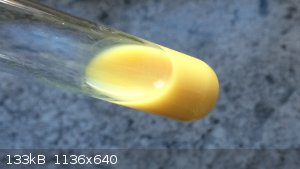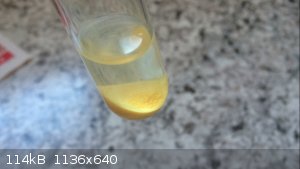The Volatile Chemist
International Hazard
    
Posts: 1981
Registered: 22-3-2014
Location: 'Stil' in the lab...
Member Is Offline
Mood: Copious
|
|
Use of Iron-Cyanide Anion Salts as Indicators
This is the entirety of the article, below:
It can be found at: http://ptp.x10.mx/storage/ICCAs.txt
Some help in regards to formatting, revision, review, etc. would be very much appreciated.
Use of Iron-Cyanide Anion Salts as Indicators
Published by the Peppertree Labs consortium of persons, PT Labs, (PTL)
Originally made: 2015
Contributing Authors: Nathan J. Pimental
++Introduction++
This document describes in detail the use of iron cyanide anionic salts as indicators in chemistry, specifically in regards to their use as
indicators of the presence of metallic cations, as well as their use in selective precipitation. This document will continually be modified by PT Labs
as more information is gained on the topic. All information ever stated in this document will be kept as part of the document for citation purposes,
but any statement made may be subject to future written denial within the document. Any statement may be later deemed untrue, and although it will be
kept within the document, it will be noted as untrue.
The below two entries are from the list published by PT Labs entitled 'Peppertree Labs Chemical Tests'. The two indicators described below will be
discussed in detail, among other iron-cyanide indicators, within this document.
PTLct - 1: Components: Zinc Ferrocyanide, in water solution or as powder.
Qualities: White, powdery and granular compound. Produces metal ferrocyanides upon mixture with metal ions. It can be used to detect which
metal ions exist within a solution, usually forming a colored precipitate. This chemical test compound is better than potassium ferrocyanide and
potassium ferricyanide because it is white, not yellow or red, and is insoluble. All products are also insoluble, and the zinc ion is relatively
cheap, easily recovered, and easily precipitated from solutions. It is also very sensitive to small amounts of chemicals.
PTLct - 2: Components: Equimolar ratio of Potassium Ferricyanide and Potassium Ferrocyanide in water.
Qualities: Orange-Yellow solution, components are slightly hard to dissolve in water. A good way to test for iron ions, and be able to
tell which ion is present. Also works for various other metal ions, the quantity of precipitate resulting from the mixture of the compounds also
allows for inference as to which metal ion or ions are present.
In this document, the acronym 'ICCA' will be used to mean 'Iron-Cyanide Complex Anion'. It will be pluralized 'ICCAs'. This Document also will refer
to the two ICCAs 'Hexacyanoferrate(II)' and 'Hexacyanoferrate(III)' as 'Ferrocyanide' and 'Ferricyanide', respectively.
++Potassium Hexacyanoferrate (II) and (III) as Indicators++
The ICCA hexacyanoferrate(III) is most commonly found as potassium hexacyanoferrate(III), commonly called potassium ferricyanide. This salt has a
red-orange color, and readily makes solutions, which are usually bright yellow in color, with a slight tint of orange. It has a charge of -3.
The ICCA hexacyanoferrate(II) is most commonly found as a potassium or sodium salt. It it banana yellow in color, but lacks the opaque qualities
that usually are attributed to such a color. It makes faint yellow solutions. It is known also as ferrocyanide, and has a charge of -4.
Both salts are rather soluble, but should never be heated, or introduced to a strong, acidic environment. These conditions described can easily
cause the release of some of the cyanide ligands, forming, most likely, copious amounts of hydrogen cyanide gas.
In the following description of the two ICCAs directly above, the following metal salts will be used as a source of metal ions in the comparison:
(In no order)
Copper(II) Nitrate
Zinc(II) Nitrate
Calcium Nitrate
Nickel(II) Nitrate
Magnesium Sulfate
Lead(II) Nitrate
Cobalt(II) Chloride
Aluminum Sulfate
Iron(III) Ammonium Sulfate (For Fe(III) ions)
Iron(II) Sulfate
Barium Nitrate
The following list displays the coloration of the ion's precipitate on mixture with potassium ferrocyanide and potassium ferricyanide. The initial
solution color (ISC) is the color of the dissolved reactant containing the metal ion. The term N/P represents 'no precipitate'.
Cu(II)-ISC:Pale blue. Hexacyanoferrate(III) Precipitate:Greenish-brown coloration. Hexacyanoferate(II) Precipitate:Dark, deep brown, rather red,
eventually almost black color; starts out almost as the color of copper metal, must be given some time to fully react.
Zn(II)-ISC:Clear. Hexacyanoferrate(III) Precipitate:An orange form of tan, pale. Hexacyanoferate(II) Precipitate:White, very slightly grey, but mostly
a dull white.
Al(III)-ISC:Clear. Hexacyanoferrate(III) Precipitate:N/P but hazy solution, slight insoluble product may be formed. Hexacyanoferate(II)
Precipitate:N/P but hazy solution; time may cause the precipitation of a slight, white powder.
Co(II)-ISC:Pink form of red, cherry, strawberry-like coloration. Hexacyanoferrate(III) Precipitate:Very, very dark form of red-brown.
Hexacyanoferate(II) Precipitate:Bright green, dulls over time (long period storage of the precipitate turns it almost black), green is similar to that
of a watermelon rind.
Pb(II)-ISC:Clear. Hexacyanoferrate(III) Precipitate:Hazy, dusty brown, which lacks the orange or green tints, mostly, of other precipitates from
Hexacyanoferrate(III); in that way discern-able from copper(II) and zinc(II) precipitates by the ICCA ferricyanide
Ba(II)-ISC:Clear. Hexacyanoferrate(III) Precipitate:N/P but hazy solution, slight insoluble white product may be formed.
Ca(II)-ISC:Clear. Hexacyanoferrate(III) Precipitate:N/P
Mg(II)-ISC:Clear. Hexacyanoferrate(III) Precipitate:N/P
Ni(II)-ISC:A teal-green color. Hexacyanoferrate(III) Precipitate:Hazy, orange-brown, more orange than brown. Discern-able from precipitate of zinc
because it does not settle as readily, and is slightly more orange. It is best differentiated using a different indicator, ex. ferrocyanide instead of
ferricyanide.
Fe(II)-ISC:Pale green. Hexacyanoferrate(III) Precipitate:Dark blue, very similar to the Fe(III) precipitate, possibly the dye Prussian blue, or
similar compound. Hexacyanoferate(II) Precipitate:Teal-green color, with a slightly more green solution color than initially.
Fe(III)-ISC:A deep yellow. Hexacyanoferrate(III) Precipitate:N/P, but an intensifying of the yellow color. Hexacyanoferate(II) Precipitate:Very dark
blue, very similar to the Fe(II) precipitate, possibly the dye Prussian blue, or similar compound.
++PTLct - 1 and 2++
PTLct - 1 and PTLct - 2 are two chemical indicator tests developed by Peppertree Labs (PT Labs, or PTL) for the indication of the presence of metal
ions. PTLct - 2 is superior to Potassium Hexacyanoferrate (II) or (III) because most metals produce very uniquely colored precipitates. PTLct - 1 is
not as generally useful, but can be used to specifically separate otherwise similar metal ions, like cobalt(II) and copper(II), and Iron (II) and
(III).
PTLct - 1 is an off-white precipitate, formed when potassium hexacyanoferrate(II) is reacted with zinc ions, the PTLct - 1 used in this
experimentation came from zinc sulfate. It forms a fine powder, but is also slightly granular. It should be used in very small amounts. This is part
of why it was designed, to be an indicator that did not requite much of itself to 'indicate'. Thus, very small amounts may be put in acidic or hot
environments as long as safety measures are taken, without much production of HCN gas. This indicator works by precipitating a little of the metal
ions it is indicating for onto the granule of the indicator's surface. The color of the precipitate determines the metal ion present. There are many
metal ions that do not react or precipitate with PTLct - 1 immediately, or even ever. The list below contains many tested ions, many of which did not
react. N/P indicates no precipitate noticed, immediately. It says nothing of precipitates after long periods of time. Nonetheless, PTLct - 1 may be a
good long term indicator for certain specific ions in a solution over time, while ignoring others. Perhaps it could be used to purify solutions that
contain ions this indicator precipitates.
Copper(II) (Copper(II) nitrate): Starts light brown, turns darker quickly, eventually a deep brown/black/grey.
Zinc(II) (Zinc(II) nitrate): N/P
Aluminum(III) (Aluminum sulfate): N/P
Cobalt(II) (Cobalt(II) chloride): Light teal-blue color, gets darker over time, appears purple-ish because of solution coloration, but not actually
this color.
Lead(II) (Lead(II) nitrate): N/P
Calcium (Calcium nitrate): N/P
Nickel(II): N/P
Iron(II) (Iron(II) sulfate): Teal-like color similar to that of the precipitate of cobalt(II) ions by this indicator
Iron(III) (Iron(III) ammonium sulfate, or 'ferric ammonium sulfate'): N/P
PTLct - 2 is useful as an indicator because it produces precipitates slightly easier to differentiate than either potassium ferrocyanide or
potassium ferricyanide. It is an orange-ish yellow solution, which readily evaporates to form orange-like precipitates. It, too, can be used in small
amounts, but is less effective this way. Solutions of PTLct - 2 keep better if dilute, but are more effective when in concentrated form. The below
list contains the color some metal ions precipitate when introduced to PTLct - 2. All ions mentioned are from the salts mentioned in past lists. N/P
means no precipitate.
Cu(II): Milk chocolate brown, eventually slightly darker.
Zn(II): Golden yellow, rather orange.
Al(III): N/P
Co(II): Very dark brown, hints of red, almost black.
Pb(II): Light banana yellow.
Ca: N/P
Ni(II): Brownish mustard yellow.
Fe(II): Very dark navy blue.
Fe(III): Very dark, almost black, sea blue, hits of green.
++The Qualities of Simple ICCA Precipitates and Conclusions About the Above Methods++
The precipitates formed from the indication processes discussed above have many forms. Some are powdery and granular, easily separable from
solution. Others form such a fine precipitate that they suspend in water for long periods of time as a colloid.
Some precipitates may not be salts of the ferrocyanide or ferricyanide complex, though it is hard to tell. It is even possible zinc-cyanide
complexes play a part in the results of the PTLct - 1 indicator. Some may be cyanides of the metal ions. Thus, in general care must be taken in the
process. Still, the procedures above show promising qualities for their usage in specific, and hopefully even general capacities; as indicators and
selective precipitation compounds.
[Edited on 1-18-2015 by The Volatile Chemist]
[Edited on 1-18-2015 by The Volatile Chemist]
|
|
|
Mailinmypocket
International Hazard
    
Posts: 1351
Registered: 12-5-2011
Member Is Offline
Mood: No Mood
|
|
Thought I would try cadmium sulfate with PTL-ct2, it produces a light yellow precipitate:
 
[Edited on 21-1-2015 by Mailinmypocket]
Note to self: Tare the damned flask.
|
|
|
The Volatile Chemist
International Hazard
    
Posts: 1981
Registered: 22-3-2014
Location: 'Stil' in the lab...
Member Is Offline
Mood: Copious
|
|
Wow, that's rather pretty. Very similar to lead(II)'s precipitate, but that has more orange, lead(II) made a banana color. I'll add it as an
unverified results portion soon. Thanks for the contribution, I thought I wouldn't get any replies.
|
|
|
Boffis
International Hazard
    
Posts: 1837
Registered: 1-5-2011
Member Is Offline
Mood: No Mood
|
|
Somewhere I have come across a similar technique that consists of filter paper impregnated with zinc ferrocyanide but I can't remember where I have
seen it but probably Vogel or Feigl.
There is also a test for zinc based on the delicate balance between ferrocyanide-ferricyanide and an organic redox indicator. The zinc precipitates
the ferrocyanide and upsets the equilibrium causing the ferricyanide to oxidize the indicator. This reaction is covered in Feigl and Anger "Spot tests
in inorganic analysis" p511.
|
|
|
The Volatile Chemist
International Hazard
    
Posts: 1981
Registered: 22-3-2014
Location: 'Stil' in the lab...
Member Is Offline
Mood: Copious
|
|
Quote: Originally posted by Boffis  | Somewhere I have come across a similar technique that consists of filter paper impregnated with zinc ferrocyanide but I can't remember where I have
seen it but probably Vogel or Feigl.
There is also a test for zinc based on the delicate balance between ferrocyanide-ferricyanide and an organic redox indicator. The zinc precipitates
the ferrocyanide and upsets the equilibrium causing the ferricyanide to oxidize the indicator. This reaction is covered in Feigl and Anger "Spot tests
in inorganic analysis" p511. |
The first is likely something else, as it seems zinc ferrocyanide is used as a semi-permeable membrane: http://ecx.images-amazon.com/images/I/51mMfBkvBXL._SX258_BO1...
The other isn't just for zinc, it's useful for lots of metal ions, that's why it's described in the article.
|
|
|
|